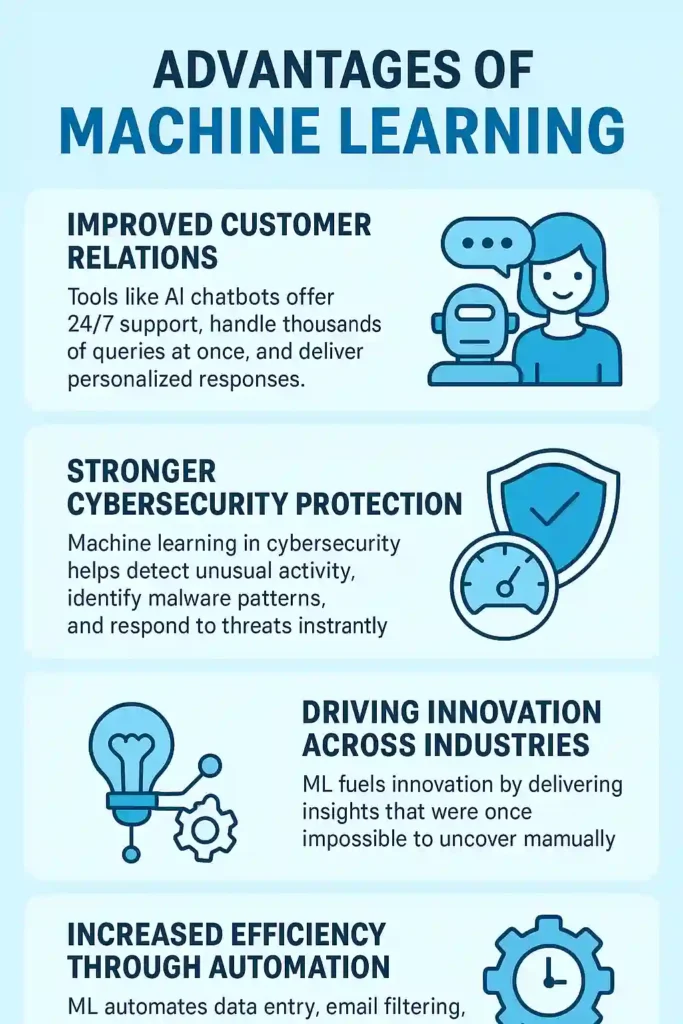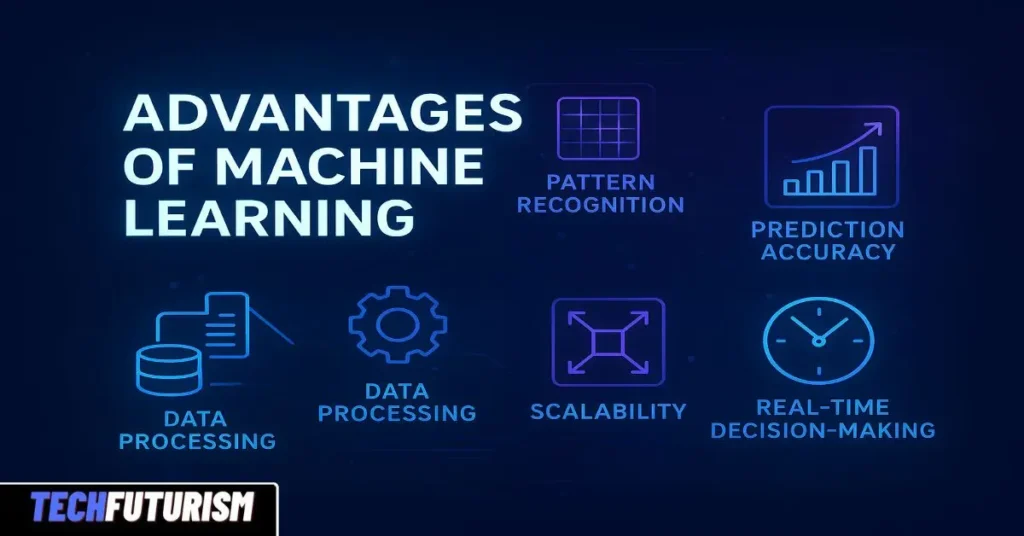Machine learning (ML) has rapidly evolved into one of the most powerful technologies shaping our digital world. From boosting cybersecurity to improving customer experiences, the advantages of machine learning continue expanding across industries. But what makes ML so transformative? And how can you use it confidently in your business or personal projects?
In this comprehensive guide, you’ll learn the key benefits of ML, its common uses, its disadvantages, expert insights, real-life anecdotes, step-by-step instructions, and semantically optimized sections that boost search visibility.
Let’s get started.
- Advantages and Disadvantages of Machine Learning: A Balanced Introduction
- Advantages of Machine Learning (Primary Focus)
- Advantages of Deep Learning
- Uses of Machine Learning
- Disadvantages of Machine Learning
- Disadvantages of Machine Learning in Education
- Challenges of Machine Learning
- Advantages of Machine Learning PDF
- Advantages of Machine Learning PPT
- Step-by-Step Guide: How to Implement Machine Learning in Your Business
- Why You Can Trust Machine Learning for Your Business
- FAQ Section: Common Questions About Machine Learning & AI
Advantages and Disadvantages of Machine Learning: A Balanced Introduction
Before diving into the benefits, it’s important to understand the bigger picture.
Machine learning is the technology that allows computers to learn patterns from data and make decisions without explicit programming. The main advantage is that ML can analyze huge datasets faster and more accurately than humans. However, one disadvantage is that it relies heavily on high-quality data—which isn’t always available.
This balance helps businesses carefully plan ML adoption while avoiding unrealistic expectations.
Advantages of Machine Learning (Primary Focus)
Machine learning is widely known for its efficiency, automation capabilities, and ability to support smart decision-making. Let’s explore its biggest benefits in clear, practical language.

1. Improved Customer Relations
One of the most impactful advantages of machine learning is its role in strengthening customer interactions.
Tools like AI chatbots offer 24/7 support, handle thousands of queries at once, and deliver personalized responses.
Anecdote:
A boutique online shop owner shared that customers used to wait hours for email replies. After adding a chatbot, response times dropped to seconds. Customers returned more frequently—and her sales increased.
ML improves customer relations by:
- Offering personalized product recommendations
- Improving user segmentation
- Predicting customer needs
- Increasing loyalty through consistent, friendly engagement
2. Stronger Cybersecurity Protection
Cybersecurity threats grow every year, and machine learning has become a critical defense layer.
Machine learning in cybersecurity helps:
- Detect unusual activity
- Identify malware patterns
- Spot fraudulent transactions
- Respond to threats instantly
Because many attacks follow repeatable code structures, ML learns from past incidents and prevents similar attacks in the future. This ability to evolve continuously is one of ML’s biggest strengths.
3. Driving Innovation Across Industries
ML fuels innovation by delivering insights that were once impossible to uncover manually.
Example:
A healthcare research team used ML to analyze thousands of X-rays and discovered new early signs of lung disease. This accelerated diagnostic success and helped save lives.
ML supports innovation in:
- Healthcare diagnosis
- Marketing strategies
- Engineering design
- Financial forecasting
- Product development
With each new dataset, the system learns more—unlocking new creative possibilities.
4. Increased Efficiency Through Automation
Automation is another top advantage of machine learning. ML systems process large data volumes quickly, allowing companies to eliminate repetitive tasks.
ML automates:
- Data entry
- Email filtering
- Fraud detection
- Predictive maintenance
- Inventory management
This saves time, cuts costs, and allows employees to focus on high-value tasks that require human creativity.
5. Higher Accuracy & Reduced Human Errors
Because ML systems don’t suffer from fatigue or distraction, they are ideal for tasks requiring precision.
Over time, ML continuously improves by learning from previous patterns. This makes it extremely accurate for:
- Medical diagnosis
- Financial predictions
- Language translation
- Quality control in manufacturing
In many industries, ML accuracy now exceeds human performance.
Advantages of Deep Learning
Deep learning—a specialized form of ML—uses neural networks to mimic human brain processing. It excels at interpreting complex data like images, sound, and text.
Deep learning benefits include:
- Extremely high accuracy
- Ability to analyze unstructured data
- Superior performance in vision and speech tasks
- Self-improving results with large datasets
It powers technologies like self-driving cars, ChatGPT, medical imaging, and voice assistants.
Uses of Machine Learning
ML now impacts nearly every part of our daily lives. The uses of machine learning include:
- Healthcare: disease detection, personalized medicine
- Finance: fraud detection, loan approval automation
- Retail: dynamic pricing, product recommendations
- Transportation: route optimization, driver-assistance systems
- Marketing: audience targeting, customer segmentation
Wherever data exists, ML can create value.
Disadvantages of Machine Learning
Although ML offers many benefits, it also presents challenges:
- Dependence on high-quality data
- Costly and complex model training
- Risk of bias if bad data is used
- Limited interpretability (“black box” models)
Understanding these helps businesses make responsible decisions.
Disadvantages of Machine Learning in Education
In the education sector, ML improves learning but also brings risks:
- Biased grading or assessments
- Privacy concerns for student data
- Over-reliance on automated teaching tools
- Reduced human interaction
This is why schools should adopt ML carefully and ethically.
Challenges of Machine Learning
Some common challenges of machine learning include:
- Data scarcity
- Model overfitting
- High computational resource needs
- Ethical concerns
- Difficulty explaining decisions in complex models
Despite these challenges, rapid research continues to improve ML capabilities.
Advantages of Machine Learning PDF
Many readers search for downloadable guides. Here is a reliable resource:
Download ML Advantages PDF
Advantages of Machine Learning PPT
Useful for presentations and teams:
ML Benefits PPT
Step-by-Step Guide: How to Implement Machine Learning in Your Business
Here’s a simple roadmap that any business can follow:
Step 1: Identify repetitive or data-heavy problems
Look for tasks with clear patterns or prediction needs.
Step 2: Gather clean, well-structured data
Data quality directly affects model accuracy.
Step 3: Choose the right ML model
Options include supervised, unsupervised, or reinforcement learning.
Step 4: Train your model
Feed your dataset into the system and let it learn patterns.
Step 5: Evaluate performance
Check accuracy, precision, recall, and error rates.
Step 6: Deploy and monitor
Integrate ML into your workflow and update the model regularly.
Machine learning also uses methods like Bayesian Learning in Machine Learning, which helps the system make better decisions by updating predictions as new data comes in
Expert Insight
“Machine learning isn’t just a tool; it’s the backbone of modern innovation.”
— Dr. Andrew Ng, AI Visionary & Co-founder of Google Brain
Why You Can Trust Machine Learning for Your Business
Machine learning is more than a trend—it’s a long-term investment in efficiency, accuracy, and smarter decision-making. As ML models learn and improve with time, your systems become more effective, your errors decrease, and your productivity increases.
Implementing ML today gives your business a powerful competitive advantage tomorrow.
FAQ Section: Common Questions About Machine Learning & AI
1. What are the strengths and weaknesses of ML?
Strengths:
Machine learning is great at finding patterns in data, making accurate predictions, and automating repetitive tasks. It can analyze huge amounts of information much faster than humans and keeps improving as it learns from new data. ML also helps businesses personalize customer experiences, detect fraud, improve efficiency, and reduce human errors.
Weaknesses:
ML requires large amounts of high-quality data to work properly. If the data is biased or incorrect, the results will also be wrong. Building ML systems can be expensive and requires experts. Some ML models are like “black boxes,” meaning it’s hard to understand how they make decisions. They can also unintentionally strengthen existing biases found in the data.
2. What are the 5 advantages and disadvantages of AI
Advantages:
Automation: AI can perform repetitive tasks without getting tired.
Accuracy: It reduces human mistakes in areas like healthcare and finance.
Speed: AI analyzes data and makes decisions much faster than humans.
24/7 Availability: AI systems don’t need breaks, sleep, or holidays.
Personalization: AI can customize products, ads, and services based on user behavior.
Disadvantages:
High Costs: Developing and maintaining AI systems can be expensive.
Job Displacement: Automation may replace some human roles.
Data Privacy Issues: AI requires large amounts of personal data, raising privacy concerns.
Bias Risks: If AI learns from biased data, it produces unfair results.
Lack of Human Judgment: AI cannot fully understand emotions, ethics, or social context.
3. What are the advantages of machines?
Machines offer many benefits, especially in workplaces and industries:
They work faster than humans and can handle tasks that require strength, precision, or repetition.
They reduce physical labor, helping people avoid dangerous or tiring jobs.
They produce consistent results, ensuring quality doesn’t change over time.
They can operate non-stop, making production more efficient.
They lower long-term costs by reducing human errors and improving productivity.
Machines are an essential part of modern life because they help us do more in less time with fewer mistakes.
4. What are the disadvantages of using machine learning?
While machine learning offers many benefits, it also comes with some downsides:
High Data Requirements: ML needs large amounts of clean, accurate data.
Expensive to Implement: Training ML models requires powerful computers and skilled professionals.
Lack of Transparency: Some models are difficult to explain, making their decisions hard to justify.
Bias and Fairness Issues: If the training data is biased, ML models may produce unfair or discriminatory results.
Maintenance Needs: ML systems must be updated regularly to stay accurate and effective.
Despite these drawbacks, ML remains one of the most powerful and useful technologies in the world today.

